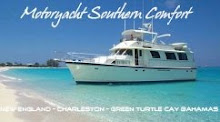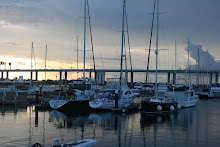The black and white photograph of the house is a portrait of time frozen.
On sunny day in 1956, between airing out the rugs and spring cleaning, life came to a stop as someone innocently clicked the shutter on a 35mm Kodak camera. The photo would become a postcard and nearly two decades later that post card was placed carefully in a young boy's suitcase. That post card has been with me ever since.
Way back in time I spent several nights at the Massoletti Fishing Lodge. Too young to know anything except it was the coolest place, simple, rustic, with knotty pine paneling, stone faced fireplace, fishing rods and reels, and black and white photos of people I didn't know. There was a wooden screen door with far too many coats of paint, that slapped shut with each gust of wind from the mighty Atlantic.
The house stood alone, and across the highway that was randomly covered with blowing wisps of sand, there were the magnificent dunes of Cape Hatteras and the endless miles of beach along the vast Atlantic Ocean.
Down the road about a ¼ mile or so, stood a single hotel and a couple of seafood restaurants. It was as remote a place as I've ever seen, windswept, cold and completly void of tourists in the early spring of 1971.
So when friends offered a weekend stay at the Outer Banks a few weeks ago, I thought of that post card, and the many years that had passed, as I accepted their invitation.
But you can't get there from here.
When God made the Carolinas he also made the bays, rivers and barrier islands that protect the low country. But his grand plan had one major flaw in that you can't get to the Outer Banks from Charleston or from anywhere else for that matter.
I turn onto Highway 17 and head north. Soon I'm crossing the Arthur J. Ravenel, Jr. Bridge expecting to leave Charleston behind and wander up the rural Carolina Coast on a road trip in search of my own past..But Charleston becomes Mount Pleasant which becomes Georgetown and then Myrtle Beach and it all runs together. There is a short break in the congestion outside of
Wilmington but for the most part Highway 17 North is strip malls, outlet centers, water parks and everything things else from Hooters to The Dixie Stampede, with mile after mile of billboards to make sure you don't miss any of it.
Once past Wilmington I head towards New Bern. The two hour twenty five minute ferry ride from Cedar Island ends at Ocracoke Island at 5:20. Then there is a five min drive to the other end of the island to catch the 5:40 ferry to Hatteras.
All of this careful planning would put me at my friend's rented beach house around 6:15. Unless, I miss the 3 o'clock ferry. Then I'll spend nearly three extra hours driving around the long way or at least several hours waiting at the dock for the 6 o'clock ferry.
Once across the North Carolina state line, a quick calculation determines that the 3 o'clock ferry to Hatteras will pull away from the dock without me. There's no way given the traffic that I'll make it in time, so I'm off across the back roads of Eastern North Carolina.
The zig zag maze of roads needed to drive around the Pamlico Sound requires use of a tattered and somewhat out of date North Carolina map. There are a dozen ways to drive the New Bern to Hatteras route, none of them are good. I soon understand why waiting on the 6 o'clock ferry would have been the better choice, the drive is never ending and the speed limit is 45 most of the way.
The round about route to Cape Hatteras and the famous Hatteras lighthouse requires crossing the 2.5 mile long ribbon of concrete known as the Herbert Bonner Bridge. The bridge built in 1963, looks fine, however state inspectors have all but condemned the bridge due to corrosion, crumbling concrete and rusting steel.
I slow my SUV to have a personal inspection. There's noticable wear and rust and missing bolts, and missing concrete.
The wind off the Atlantic blows fierce and gusts push my SUV sideways towards the water. I scan the bridge ahead being vigilant for any sign of missing sections which would mean certain death as I plunge the forty or so feet to the Pamlico Sound below, but the view is impressive. Water is everywhere and the expansive sound seems to go on forever in all directions as the sun sets over the distant horizon.
By the time I escape death on the bridge and return to terra firma, it is dark. The tourists are gone and the outer banks have already begun to take on the look of a ghost town. Many stores and restaurants have signs that say "closed for the season" or "re-opening April 1st. Frankly winter is the best time to visit the Outer Banks of North Carolina.
A couple of u turns are needed to locate my nights lodging. Of course you can't get lost on the outer banks since the one road only goes north and south. The trouble is, as the locals will advise you, "drive more than 30 seconds east or west you are going to get wet".
At last I pull into the gravel drive of the address I've written down and pull my aching body out of my SUV. It's nearly 8 PM just over nine hours to drive up the coast from Charleston on a Saturday.
The wind blows strong out of the north and in the darkness the sound of the Atlantic Ocean is overwhelming, even though it's almost a quarter mile away.
Friends and I head off for dinner, so my hunt for the Massoletti Fishing Lodge will have to wait until the morning.
Dawn brings a tragic realization; progress has come to the outer banks.
Finding the Massoletti Fishing Lodge won't be easy. The once long stretch of empty beach is now crowded with modern houses and four story hotels where dunes and sea oats once stood.
Myrtle Beach now extends all the way to Nags Head and Kitty Hawk, a sad commentary that we value the new and discard the old. Once a clear sweeping view of the Atlantic Ocean is now the private gated entrance to a collection of multi million dollar homes and condos, the hodge podge of shops and condos has a dizzying effect. Tasteful is right next to tacky, lavish opulence is right next door to lazy weathered outdatedness.
The Massoletti Lodge is Gone.
Where once stood the Massoletti fishing lodge now stands thirty or so modern condos all four stories high in Charleston Rainbow Row colors.
I show the post card to a nice lady at the local visitor center. A friendly senior who knows the house, and explains when I ask are you sure? "Of course I'm sure my father built that house, for Joe Massoletti."
The Massoletti family came to America in the early 1800s from Italy. As with many who came to America, the Massoletti family settled into a new life in New York City.
Joseph D. Massoletti operated a restaurant at 70 Pine Street, in New York City, from the 1940s until the 1970s. The restaurant served fine southern Italian cuisine and maintained a world class wine cellar. Wall Street executives patronized Massoletti's. Merrill Lynch even maintained their offices in the same building.
Around 1946 Joe Massoletti built what he named the Massoletti Fishing Lodge, far removed from the big city life his family had known for more than a century the Massoletti home was built by Hatteras local George Oden whose family still runs the Oden docks at Hatteras village and whose daughter volunteers at the visitors center.
Joe so loved the outer banks that he once invited a group of sports writers from New York down for a weekend in order to promote the area's deep sea fishing. The ocean was rough, fishing was terrible and apparently, the mosquitoes were so bad that weekend that not one of the writers gave a good review.
Over the years Massoletti entertained the Delmonicos and other famous New Yorkers until the lodge was sold to the Powell's of Charlotte, NC in 1970. It was the Powell's who invited my father and his young family to visit the Outer Banks a year later.
Joseph Massoletti passed away in 1973 and the famous New York restaurant closed in 1976.
Hurricane Isabel made a pretty big impact on the barrier island back in 2003 wiping out Highway 12 with a hole so large that it took nearly six months to repair the damage. The storm was so severe that many beachside homes were simply swept out to sea.
Yet the Massoletti Fishing Lodge survived unscathed just as it had withstood so many hurricanes and storms during the preceding 50 years.
A New View
Early in 2005 the Massoletti Lodge was moved about a block west to the Pamlico side of the Hatteras Village to make way for a "new" development. Where it once offered a view of the dunes across highway 12 the lodge now offers a view of the Pamlico Sound.
The home still retains much of the look from 50 years ago, the knotty pine and hardwood floors have been restored, pegs on the walls for fishing rods and even the small kitchen are just as I remember them from my youth. The screen porch is gone and with it the screen door that kept me awake so long ago. The rest of the house has been raised up on pilings to a two story level.
Much the reason I suspect the place survived all these years was the low profile design that was nestled amongst the dunes.
All buildings that date from the early 1900's have the same low profile, those who came to the islands and built Victorian style three story houses found out quickly that the Atlantic storms were simply too much as their homes soon fell to power of the Atlantic and mother nature.
As with most visits to the past, the trip is too short and memories are somewhat bittersweet.
The Massoletti Fishing Lodge is still standing, but progress has taken its toll. The once remote Outer Banks are no more, having lost the battle to greed and urban sprawl.
My trip in search of the Massoletti Fishing Lodge just confirms my belief that most often, new and improved is not necessarily better.
Tuesday, December 4, 2007
Subscribe to:
Post Comments (Atom)





No comments:
Post a Comment